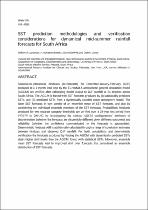 ResearchSpace
ResearchSpace
SST prediction methodologies and verification considerations for dynamical mid-summer rainfall forecasts for South Africa
JavaScript is disabled for your browser. Some features of this site may not work without it.
- ResearchSpace
- →
- Research Publications/Outputs
- →
- Journal Articles
- →
- View Item
| dc.contributor.author |
Landman, WA

|
|
| dc.contributor.author |
Beraki, Asmerom F

|
|
| dc.contributor.author |
DeWitt, D

|
|
| dc.contributor.author |
Lötter, D

|
|
| dc.date.accessioned | 2014-10-24T13:36:08Z | |
| dc.date.available | 2014-10-24T13:36:08Z | |
| dc.date.issued | 2014-10 | |
| dc.identifier.citation | Landman, W.A, Beraki, A.F., DeWitt, D and Lötter, D. 2014. SST prediction methodologies and verification considerations for dynamical mid-summer rainfall forecasts for South Africa. Water SA, vol.40(4), pp 615-622 | en_US |
| dc.identifier.issn | 0378-4738 | |
| dc.identifier.uri | http://www.ajol.info/index.php/wsa/article/view/108048/97873 | |
| dc.identifier.uri | http://hdl.handle.net/10204/7735 | |
| dc.description | Copyright: 2014 Water Research Commission. This is an ABSTRACT ONLY. The definitive version is published in Water SA, vol. 40(4), pp 615-622 | en_US |
| dc.description.abstract | Seasonal-to-interannual hindcasts (re-forecasts) for December-January-February (DJF) produced at a 1-month lead-time by the ECHAM4.5 atmospheric general circulation model (AGCM) are verified after calibrating model output to DJF rainfall at 94 districts across South Africa. The AGCM is forced with SST forecasts produced by (i) statistically predicted SSTs, and (ii) predicted SSTs from a dynamically coupled ocean-atmosphere model. The latter SST forecasts in turn consist of an ensemble mean of SST forecasts, and also by considering the individual ensemble members of the SST forecasts. Probabilistic hindcasts produced for two separate category thresholds are verified over a 24-year test period from 1978/79 to 2001/02 by investigating the various AGCM configurations’ attributes of discrimination (whether the forecasts are discernibly different given different outcomes) and reliability (whether the confidence communicated in the forecasts is appropriate). Deterministic hindcast skill is additionally calculated through a range of correlation estimates between hindcast and observed DJF rainfall. For both probabilistic and deterministic verification the hindcasts produced by forcing the AGCM with dynamically predicted SSTs attain higher skill levels than the AGCM forced with statistical SSTs. Moreover, ensemble mean SST forecasts lead to improved skill over forecasts that considered an ensemble distribution of SST forecasts. | en_US |
| dc.language.iso | en | en_US |
| dc.publisher | Water Research Commission | en_US |
| dc.relation.ispartofseries | Workflow;13555 | |
| dc.subject | Atmospheric general circulation model | en_US |
| dc.subject | AGCM | en_US |
| dc.subject | Seasonal forecasting | en_US |
| dc.subject | Mid-summer rainfall predictions | en_US |
| dc.subject | South African rainfall predictions | en_US |
| dc.title | SST prediction methodologies and verification considerations for dynamical mid-summer rainfall forecasts for South Africa | en_US |
| dc.type | Article | en_US |
| dc.identifier.apacitation | Landman, W., Beraki, A. F., DeWitt, D., & Lötter, D. (2014). SST prediction methodologies and verification considerations for dynamical mid-summer rainfall forecasts for South Africa. http://hdl.handle.net/10204/7735 | en_ZA |
| dc.identifier.chicagocitation | Landman, WA, Asmerom F Beraki, D DeWitt, and D Lötter "SST prediction methodologies and verification considerations for dynamical mid-summer rainfall forecasts for South Africa." (2014) http://hdl.handle.net/10204/7735 | en_ZA |
| dc.identifier.vancouvercitation | Landman W, Beraki AF, DeWitt D, Lötter D. SST prediction methodologies and verification considerations for dynamical mid-summer rainfall forecasts for South Africa. 2014; http://hdl.handle.net/10204/7735. | en_ZA |
| dc.identifier.ris | TY - Article AU - Landman, WA AU - Beraki, Asmerom F AU - DeWitt, D AU - Lötter, D AB - Seasonal-to-interannual hindcasts (re-forecasts) for December-January-February (DJF) produced at a 1-month lead-time by the ECHAM4.5 atmospheric general circulation model (AGCM) are verified after calibrating model output to DJF rainfall at 94 districts across South Africa. The AGCM is forced with SST forecasts produced by (i) statistically predicted SSTs, and (ii) predicted SSTs from a dynamically coupled ocean-atmosphere model. The latter SST forecasts in turn consist of an ensemble mean of SST forecasts, and also by considering the individual ensemble members of the SST forecasts. Probabilistic hindcasts produced for two separate category thresholds are verified over a 24-year test period from 1978/79 to 2001/02 by investigating the various AGCM configurations’ attributes of discrimination (whether the forecasts are discernibly different given different outcomes) and reliability (whether the confidence communicated in the forecasts is appropriate). Deterministic hindcast skill is additionally calculated through a range of correlation estimates between hindcast and observed DJF rainfall. For both probabilistic and deterministic verification the hindcasts produced by forcing the AGCM with dynamically predicted SSTs attain higher skill levels than the AGCM forced with statistical SSTs. Moreover, ensemble mean SST forecasts lead to improved skill over forecasts that considered an ensemble distribution of SST forecasts. DA - 2014-10 DB - ResearchSpace DP - CSIR KW - Atmospheric general circulation model KW - AGCM KW - Seasonal forecasting KW - Mid-summer rainfall predictions KW - South African rainfall predictions LK - https://researchspace.csir.co.za PY - 2014 SM - 0378-4738 T1 - SST prediction methodologies and verification considerations for dynamical mid-summer rainfall forecasts for South Africa TI - SST prediction methodologies and verification considerations for dynamical mid-summer rainfall forecasts for South Africa UR - http://hdl.handle.net/10204/7735 ER - | en_ZA |





